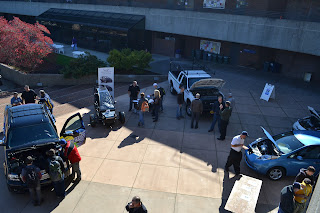Last year was huge for wearable and implantable medical devices. Researchers here in Corvallis and around the world made significant progress toward developing new technologies that will facilitate a boom in telemedical devices and services in the years to come.
Advances include the manufacturing of flexible organic implantable transistors and systems on a chip designed to be worn by patients. These allow for real-time diagnostics and the facilitation of telemedicine to implantable devices that are wireless and even self propelled.
But you may be wondering what exactly wearable medical devices are, how they work, and how they are related to telemedicine. Telemedicine is simply an expansion of the traditional doctor-patient relationship into the cloud. With the recent advances in information technology and mass manufacturing of advanced computer components, health care professional can now remotely diagnose patients by combining small, cheap sensors with the near-ubiquity of wireless internet and cell phones.
Power in Radio Waves
Researchers here at Oregon State University have developed a bandage-sized system-on-a-chip (SOC) that is powered by the ambient radio frequency (RF) waves that abound in our digital society—specifically, from cell phones and other RF devices within 15 feet of the SOC. The underlying technology used in the development of the chips could potentially even derive power from body heat and movement.
These SOCs are being designed with the intent of facilitating telemedicine via the remote monitoring of vital signs and other important health markers. By being powered by ambient RF the engineers were able to shrink the SOC down to the size of a postage stamp and reduce manufacturing costs to pennies per unit. The units can transmit a plethora of body measurements, including pulse rate and other cardiac-related features, perspiration, temperature, brain activity, and levels of physical movement.
Patrick Chiang, an associate professor in the OSU School of Electrical Engineering and Computer Science, said in a university press release that he and his team of graduate and undergraduate researchers had developed a SOC that incorporated traditionally bulky components into a postage stamp-sized device powered by ambient RF.
“Current technology allows you to measure these body signals using bulky, power-consuming, costly instruments,” Chiang told OSU. The researchers achieved significant improvements in power consumption, and feel that they can now make important biomedical measurements more portable, convenient, and affordable. These SOCs will be undergoing clinical trials; they would enable doctors and nurses to monitor patients from home and know immediately when cardiac events, falls, or other health-related events happen.
“The entire field of wearable body monitors is pretty exciting,” Chiang told OSU. “By being able to dramatically reduce the size, weight and cost of these devices, it opens new possibilities in medical treatment, health care, disease prevention, weight management and other fields.”But the work of Chiang and his colleagues is likely not at all limited to medical care—if temperature, perspiration, and pulse rate can be monitored, the chips could even be useful to law enforcement agencies in lie detector systems.
Pedometers Made Simple
Another example of the sensing and data collection hardware can be found at the University of California in Los Angeles where researchers have developed a wearable sensor called Smart Insole for analyzing the gait of patients.
According to their paper, published in Proceedings of the 5th International Conference on Pervasive Technologies Related to Assistive Environments, “Patients or users can wear Smart Insole for gait analysis in daily life instead of participating in gait lab experiments for hours.” Their system would enable real-world, real-time analysis which would generate data that could be used in conjunction with smart phones or other mobile devices for “fall prevention, life behavior analysis, and networked wireless health systems.”
On the communication, software, and hardware side of the equation, Dr. Roozbeh Jafari, an assistant professor of electrical engineering at the University of Texas in Dallas, has developed a small microcomputer system, no bigger than a button, specially designed to use less power and more efficiently analyze human movements. His system, depending on the modules or sensors attached to it, can be used to monitor the health or status of individual patients remotely. His main breakthrough was in optimizing the software that runs the system and in shrinking the hardware it runs on to the size of a button. Systems like this may soon be incorporated into hospital gowns or even consumer clothing.
In a press release from his university, Jafari said, “Growing demand for healthcare monitoring applications requires students, engineers, and healthcare professionals to design, develop, deploy, and operate wearable systems.”
Shocking Advancements
A patent has already been awarded to Zoll Medical Corporation of Chelmsford Massachusetts for a “wearable medical treatment device.” The device described in the patent is supposed to be capable of sensing, for example, the cardiac state of an individual. In the event of a crisis such as a heart attack or stroke, it would not only alert authorities but also could potentially deliver the necessary shocks to revive the patient or stop an arrhythmia.
Organic Implants
Going beyond wearable devices, researchers at the University of Tokyo developed the world’s first “flexible organic transistor that is robust enough to survive the high temperature medical sterilization process.” Because of problems with voltage and fears of infection from contaminants, organic transistors have not been used in medical implants up to this point, despite their benefits.
This advancement will pave the way for even smaller sensors that cannot just be worn temporarily in clothing, but can be implanted to give healthcare professionals an even higher resolution picture of your health without having to actually see you or put you at risk of infection by coming into contact with a sick individual in a waiting room. It may also enable earlier detection of potentially life-threatening health conditions before they become acute.
Swimming Through Veins
In what seems to be right out of the science-fiction tale Fantastic Voyage, researchers at Stanford University have demonstrated a device that is small enough to literally swim through your veins searching out foreign bodies.
According to a university press release, “Poon’s devices consist of a radio transmitter outside the body sending signals inside the body to an independent device that picks up the signal with an antenna of coiled wire. The transmitter and the antennae are magnetically coupled such that any change in current flow in the transmitter induces a voltage in the other wire. The power is transferred wirelessly and can be used to run electronics on the device and propel it through the bloodstream.”
The device could potentially be used for a number of applications, including specialized drug delivery, and possibly dismantling blood clots and plaques.
One California company, Scanadu, is already offering a tricorder-like device (think Star Trek) that works with smartphones to help users diagnose certain conditions and alert them when they need to seek professional help. According to their website, Scanadu is a new personalized health electronics company, with three products in its family of consumer health tools: Scanadu SCOUT, Project ScanaFlu, and Project ScanaFlo. Based at NASA-Ames Research Center, the company uses mobile, sensor, and social technology to ensure this is the last generation to know so little about its health.
If 2013 is anything like 2012 we can expect even more advances in information technology, which will mean more advances in wearable medical devices and telemedicine. There are already apps and gadgets for people to keep track of how far they have run or their blood pressure. Before long there might be apps for diagnosing more complex diseases and disorders, along with sensors and applications to help prevent the onset of debilitating conditions like diabetes.
























.jpg)